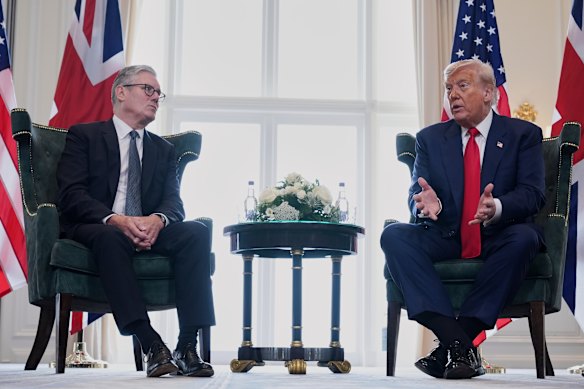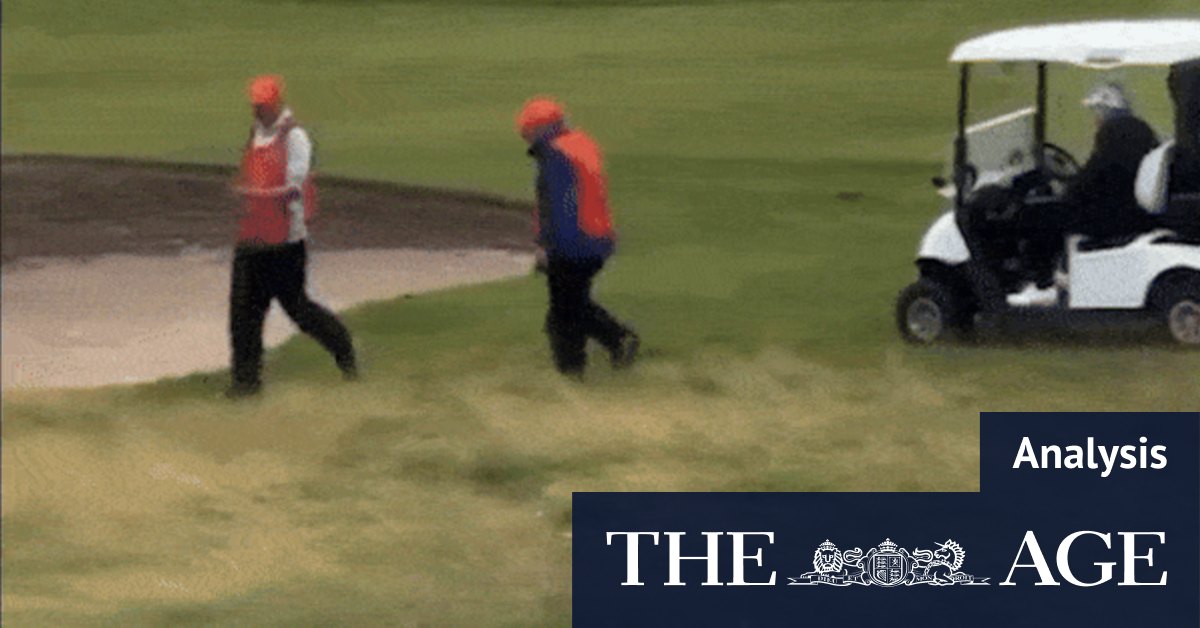Trump had a recent win with Australia when federal officials chose to allow US beef into the Australian market. The government says, unconvincingly, that this was coincidental and based on quarantine advice. There is an obvious hope that it will act as a sweetener to avert higher Trump tariffs.
The assumption is that Trump’s signal has a lasting meaning. In fact, his remarks one day can be forgotten the next. The Financial Times captured the dynamic in a headline on Monday: “Donald Trump’s hard tariff deadline dissolves into whirl of endless confusion.”

British Prime Minister Keir Starmer and US President Donald Trump at Trump’s gold course in Turnberry, Scotland.Credit: AP
The United Kingdom, meanwhile, is hoping for a tariff rate of 10 per cent. Trump said on Monday, while sitting alongside British Prime Minister Sir Keir Starmer, that he was “going to look at” a blanket 10 per cent tariff on UK exports. But he said this from the same chair where he outlined his plans for 15 to 20 per cent tariffs.
Australia is certainly heading for tariffs from 10 to 20 per cent. The temptation will be to amplify every investment in the US, as Japan and the EU did, to convince the president he has won an incredible deal. But there is no escaping the tariffs because Trump and his advisers have a stated goal of generating federal revenue from these taxes on imports.
The deeper truth is that the world is not buying enough of what America makes; Trump’s only answer is to tilt the playing field so US manufacturers are shielded by tariffs on their foreign competitors.
American consumers will pay higher prices, and American industry is unlikely to thrive. It is the policy of a Peronist – Argentina tried import substitution under Juan Peron, and it failed.
The big claims kept coming in Scotland on Monday, when Trump spoke to the media for about an hour while Starmer made some additional remarks.
For instance, Trump wants Israel to help deliver food to Palestinians in Gaza. This new call may get results, but it raises an obvious question about whether Trump applied any pressure in recent months. Is he just going through the motions?
On Ukraine, the US president also talks tough. He has just changed the terms of the deal he wanted with Russian President Vladimir Putin: a peace deal within 12 days, rather than the 50-day deadline he set two weeks ago.
Loading
In theory, the new deadline for peace in Ukraine is August 9. The old one was September 2. Trump has woken up to reality: Putin has used the generous deadline over the past few weeks to increase the missile and drone attacks and press the army to gain territory.
Trump’s deadline was no help to Ukrainian civilians. He tends to betray public indecision with his big talk, while sending conflicting signals to Putin. A former president, Theodore Roosevelt, advised leaders to speak softly and carry a big stick. Trump usually does the opposite.
As theatre, the president’s appearance on Monday combined news and entertainment in his trademark way.
But it ended with the usual questions about whether his talk was just talk. His latest tariff deals are a mess of questions and confusion. His signals on Gaza and Ukraine keep changing. No deal looks certain.
Can the world trust Trump? Ask his golf caddy.
Get a note directly from our foreign correspondents on what’s making headlines around the world. Sign up for our weekly What in the World newsletter.

